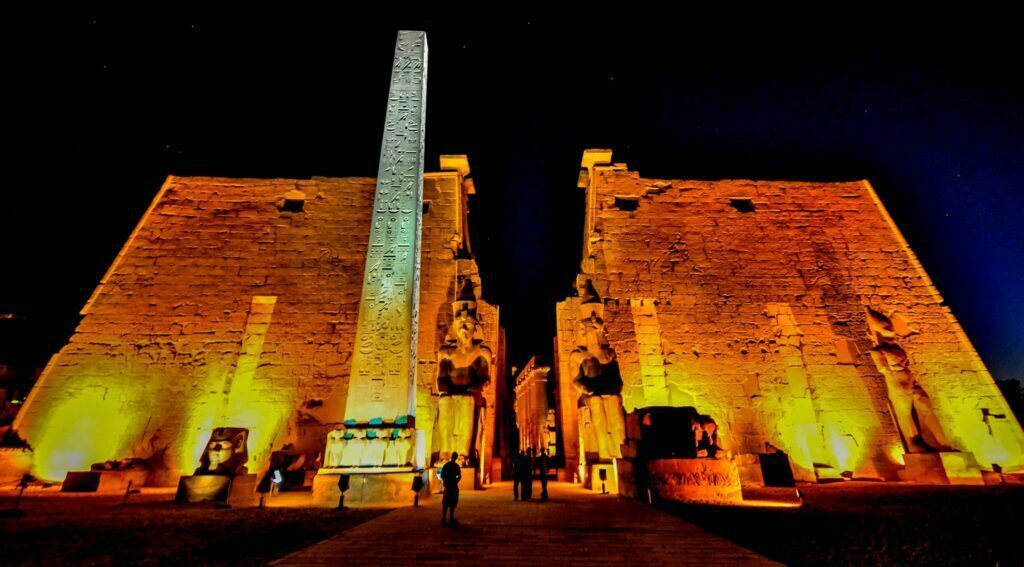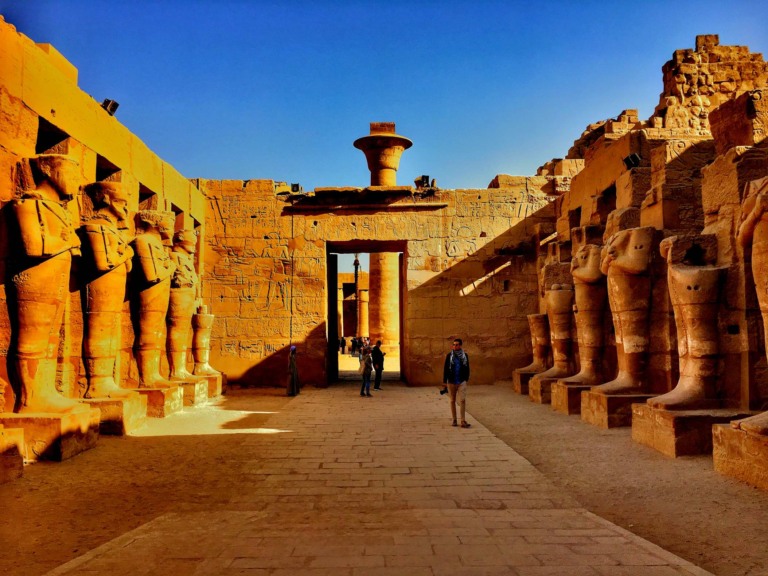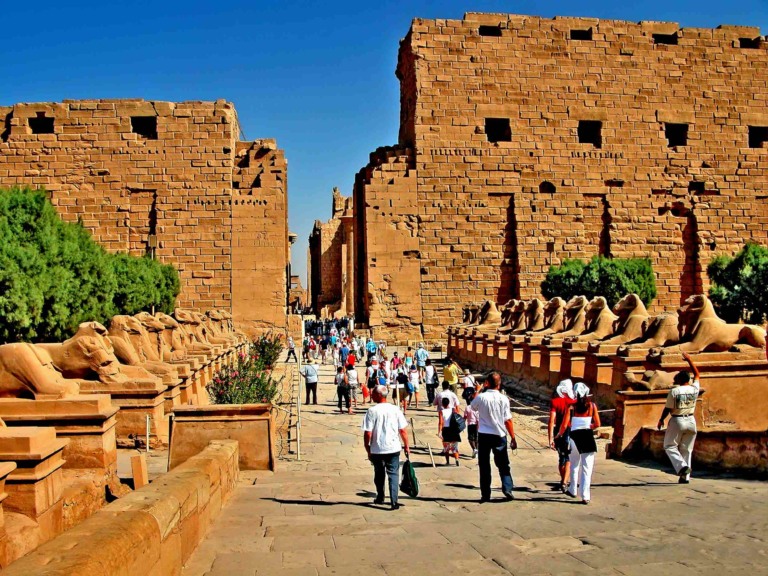Ancient Thebes with its Necropolis: The Thebes area, which includes Luxor, the Valley of the Kings, the Valley of the Queens, and Karnak, Egypt, became a UNESCO World Heritage site in 1979. During the Middle Kingdom and the New Kingdom, Egypt’s capital was Thebes, which was the city of the god Amon.
Thebes Egypt
The temples and palaces at Karnak and Luxor, as well as the tombs in the Valley of the Kings and the Valley of the Queens, show how advanced Egyptian culture was at its peak in Thebes. Thebes, in ancient Egypt (thousands of years ago), was called Wase, Wo’se, Nowe, or Nuwe. It was one of the most famous cities of antiquity and the capital of the ancient Egyptian empire when it was at its strongest.
Ancient Thebes with its Necropolis
Thebes was on both sides of the Nile River, at a latitude of about 26° N. Part of the site is now the town of Luxor, also called Al-Uqsur. It is 419 miles (675 km) south of Cairo. The area of ancient Thebes was about 36 square miles (93 square km).
The main part of the city was on the east bank of the Nile. Along the west bank was the city of the dead, or necropolis. This was where the royal tombs and mortuary temples were, as well as the homes of priests, soldiers, craftsmen, and laborers who worked hard for the Egyptian rulers.
Thebes in Ancient Egypt
Wase, or Wo’se, was the name of Thebes in the past. The fourth province of Upper Egypt, Wase, is known to have existed as early as the 4th dynasty. The oldest monuments at Thebes proper are from the 11th dynasty (2081–1939 bce), when the local governors (nomarchs) united Egypt under their rule. From then on, Thebes was often the capital of Egypt. It was called Nowe or Nuwe, which means “City of Amon,” after its main god.
The ancient Egyptian name for Luxor was Ta-ope, which may be where the Greek name for the city, Thebes, came from. During the 12th dynasty (1938–1756), the royal residence was moved to the area around Memphis. However, the Egyptian kings continued to honor Amon, their family god, so they built temples at Thebes.
After the Hyksos invaded Egypt and took over the dynastic power around 1630, they had little or no control over Thebes. The lords of that city were the ones who finally drove the Hyksos out of Egypt (around 1530–20). Then Thebes went through its best time of wealth. The pharaohs of the 18th dynasty rebuilt it and made it their capital. They decorated its temples with gifts from Asia and Nubia.
Necropolis Egypt
During the 15th century BCE, big palaces with bright colors and gardens grew on both sides of the river. There were many estates owned by noble families in the area, and foreign traders and mercenaries lived and worked among the people. In the New Kingdom, the pharaohs competed to build the biggest temples on the east bank and the biggest tomb temples on the west.
In the 14th century BCE, when Amenhotep III (Amenophis III) was king, Theban prosperity was at its highest. Much of Amenhotep III’s huge wealth from foreign tribute went into the temples of Amon. During the short time that his son Akhenaton was king (from 1353 to 1336), bad times hit Thebes. The court left the city, and worship of Amon was banned.
However, after being restored by Tutankhamen (reigned 1333-23), Thebes quickly regained its wealth and reputation, which it kept throughout the eras of Seti I (1290-79) and Ramses II (1279-13), both of whom continued to spend a portion of each year in Thebes.
Ancient Thebes
Ancient sources say that during his reign from 1187 to 1156, Ramses III gave 86,486 slaves and huge amounts of land to Amon’s temples. Under the later Ramessids, Thebes started to fall apart. It seems that the government got into a lot of financial trouble. During the reign of Ramses IX (1126–08), around 1111 bce, a series of investigations into the theft of royal tombs in the necropolis of western Thebes found evidence of corruption in high places.
This was because the mayor of the east bank accused the mayor of the west bank of being corrupt. The stolen royal mummies were moved around until the priests of Amon put them in a tomb shaft in Dayr al-Bahri and in Amenhotep II’s tomb. The fact that these two hiding places were found in 1881 and 1898, respectively, was one of the most important discoveries in the history of archaeology.
Mismanagement like this in Thebes caused trouble. Local affairs tended to be run more and more by the high priests of Amon. After the death of the last Ramses in the 11th century, the government of Egypt was split between the pharaoh in Tanis and the high pontiff in Thebes. Intermarriage and adoption brought them closer together.
At Thebes, the daughters of the Tanite kings were made “God’s Wife of Amon,” which gave them more power. In the 7th century BCE, the Nubian pharaohs made Thebes their capital. Homer talks about how rich “hundred-gated Thebes” was because of how well-known it was among the ancient Greeks.
Ashurbanipal‘s Assyrians destroyed it in 663, and even though it was rebuilt by the Saite governors, who were Assyrian vassals, it never fully recovered. By the time of Strabo (around 63 BCE to 23 CE), the city had shrunk to a small village where tourists went to see the old temples.
The Archaeology of Thebes: Four of the most important sets of ruins are talked about in different articles. Check out Karnak, Luxor, the Valley of the Kings, and the Valley of the Queens. The royal tomb temples, the palace of Amenhotep III, and the Tombs of the Nobles are also important places to see in Thebes.
During the New Kingdom, when the pharaohs hid their tombs in the secret Valley of the Kings (in western Thebes). So they had to show off their tomb temples, which were bigger and more impressive than those of their rivals. Even though they were built for rituals related to the builder’s death cult, they were all dedicated to Amon. The most important god in Thebes had the look and feel of a New Kingdom temple.
They were built in a way that mostly followed the way the land was laid out, from north to south. Most of the older ones are no longer there. Here, we’ll talk about the most important ones. The temple of Hatshepsut, who ruled from 1472 to 1458 B.C.E., is at Dayr al-Bahri. It is the largest 18th-dynasty building that is still standing and one of the most impressive.
There, in the bay of cliffs, next to the temple pyramid of Mentuhotep II, the queen’s architect, Senenmut, built (around 1473) a series of three-level colonnades and courts. From the valley, you could get to the palace through an avenue of sphinxes, and the front yard had a garden with trees and vines.
On each side of the sloped ramp that led to the next level, there was a gallery with a roof supported by two rows of columns. A similar gallery ran along the west side of the court on the next level, with chapels for Anubis and Hathor on either side. On the top terrace was a room with columns, chapels on either side, and a sanctuary dug into the side of a cliff.
Many of the reliefs that are still there in the colonnades and chapels are very beautiful and interesting. One shows how two obelisks were moved by barge from Aswan to Karnak. Another shows how Queen Ahmes married the god Amon and gave birth to Hatshepsut, and a third shows how the queen sent a trading expedition to Punt, the land of incense on the Red Sea.
Amenhotep III, who ruled Egypt from 1390 to 1353 BCE, must have had the largest and most beautiful tomb temple of all the Theban temples. Later pharaohs, on the other hand, almost completely destroyed it. Today, all that is left are a few foundations, a huge stela that is 33 feet (10 meters) tall, and two huge statues called the Colossi of Memnon.
These statues once stood at the entrance to the temple pylon but now stand alone in the middle of a field. The statues are of Amenhotep III, but the name Memnon comes from (later) Greek. Each statue was carved from a single block of stone and stood about 70 feet (21 meters) tall with its crown. After an earthquake broke the northern one, it became known as the “Singing Memnon”, because on some days, just before sunrise, it makes a strange high note.
Many Romans, including Emperor Hadrian and his wife Sabina, came to Thebes to hear this wonder, but during the reign of Septimius Severus (193–211), the statue was fixed with masonry and never “sang” again. The forecourt and pylons of Seti I’s temple at Al-Qurnah, which was built between 1290 and 79 BCE, are no longer there.
It was dedicated in part to Ramses I, who was Seti’s father. Seti’s son Ramses II, who ruled Egypt from 1279 to 1213 and is shown in the reliefs, finished it. On the walls are pictures of religious scenes in which the pharaohs make sacrifices to the gods or are helped by them. Even though it is in bad shape, the Ramesseum, or the temple where Ramses II the Great was buried, still has some of its old beauty.
The wide outer pylon has scenes of the king’s wars against the Hittites in Syria. The inner pylon has scenes from the Battle of Kadesh (1275) and the festival of the harvest god, Min. The inner court’s pillars are decorated with tall statues of the king dressed as Osiris. In the first court, there was a seated colossus of Ramses II.
Only a few pieces of it remain, but those that do show how big it was. It must have been taller than 17 meters and heavier than 1,000 tons. Beyond the second court, there is a hypostyle hall that looks like the Great Temple of Amon at Karnak. Beyond that, there used to be more pillared halls and a sanctuary that are no longer there.
Around the temple, inside the high brick wall that surrounded it, there are a lot of ruins of vaulted buildings that were probably stables, workshops, and homes for the temple staff. Diodorus Siculus, a Greek historian who lived in the first century BCE, called the Ramesseum “the Tomb of Ozymandias.” The temple of Ramses III, who was king from 1187 to 1156, is at Madinat Habu.
It is the most recent and southernmost of the great tomb temples from the New Kingdom. The general plan was based on that of the Ramesseum. It had a wide front pylon, outer and inner peristyle courts separated by a second pylon, a large hall with columns and two smaller vestibules, and the sanctuary was surrounded by smaller rooms.
The pillars in the hypostyle hall have been broken down to the level of the first or second drum, but the rest of the temple is in good shape. Scenes of the king worshiping the gods are carved on the walls of the inner halls. There are also battle scenes in which the king kills Libyans with his chariot, attacks an Amorite city, and brings Libyans, Asians, and sea raiders as prisoners to Amon and Mut.
On the outside wall of the temple, there is a lively picture of a big sea battle between the Egyptians, the Peleset (Philistines), and other sea peoples. On the outside of the great pylon is a relief of the pharaoh hunting wild cattle in a reed-covered, marshy area. This relief is also very impressive. The remains of a palace are right next to the temple. The east side of the wall around the temple area has a high gate that looks like a fortress.
Inside the precinct are other, smaller temples. One was built during the reign of Hatshepsut and Thutmose III in the 15th century BCE. But it was changed and added to during other reigns and the Ptolemaic and Roman times.
There are also a number of chapels for the dead, a sacred lake, a well, and the remains of houses and vaulted magazines made of mud brick, just like at the Ramesseum. South of the temple of Madinat Habu are the ruins of the palace of King Amenhotep III and Queen Tiy at Malkata. This building must have been one of the best in western Thebes when it was still standing. It was really four palaces, and Tiy lived in one of them.
To the southeast of Malkata, where a line of mounds can still be seen, there was a huge man-made lake that may have been a harbor for ships going down the Nile. The Tombs of the Nobles, mostly from the 18th, 19th, and 20th dynasties, are spread out over more than 2 miles (3 km) in the limestone foothills that run parallel to the river about 3 miles (5 km) away.
These tombs usually had a forecourt, a transverse chamber, a long, corridor-like room, and a chapel with statues of the dead person and his family. A shaft, or passage, ran down through the floor of the chapel to the burial chamber. After the funeral, the shaft was filled in, but the chapel and other rooms were left open so that the tomb owner’s family could visit.
Ancient Cities of Egypt
Several hundred tomb chapels can still be seen near the villages of Dira ‘Abu al-Nega’ al-Asasif, Al-Khu khah Shaykh Abd al-Qurnah, Dayr al-Madinah, and Qurnat Murai. The walls are covered with mural paintings. Many of them are very fresh and interesting, showing what ancient Egyptians did in their daily lives.
In the outer rooms of these tombs, the dead are shown checking on the workers on their estates, hunting birds or animals in the marshes or desert, listening to music, or playing checkers with their wives. From plowing to harvest, the whole year of a farmer is shown in these homey scenes.
Sculptors, metalworkers, weavers, and brick-makers go about their work, and butchers, brewers, and cooks make food for the dead. The treasurer makes his inspection rounds, and the vizier meets with foreign envoys who come to the pharaoh’s court. The roofs have patterns that look like those on houses from that time.
In the inner chapels, there are fewer scenes of everyday life. The funeral ritual is usually shown: the funeral procession crossing the Nile, the “Opening the Mouth” ceremony at the tomb door, and the funeral feast.
In the innermost chamber, the dead man and his wife are shown with Osiris and other gods going through the “weighing of the heart” or being fed by the goddess in the sacred sycamore. Most of the scenes in the tombs of the late New Kingdom are religious. There were other big cities in ancient Egypt, but none of them left such a big mark on history.
The great temples of Thebes with their historical scenes and inscriptions; the tombs with their many pictures of daily life and religious beliefs; and the many artifacts that are now in museums and private collections around the world are all part of this legacy. Ancient Thebes is one of the few places that has taught us more about early civilizations than any other.






